Main Differences Between Omnisend vs Mailchimp
- Omnisend has SMS campaigns, while Mailchimp has many different ways to get help.
- Omnisend is a marketing automation builder that connects all parts of the platform together. Mailchimp, on the other hand, lets you run ads on social media or postcards.
- Omnisend doesn’t look at how customers act to figure out how likely they are to buy, but Mailchimp does.
- Mailchimp has a mobile app, but Omnisend does not.
- Mailchimp has a website builder, but Omnisend does not.
The main thing that stood out when we looked at both of them is that Omnisend makes marketing automation much easier and more flexible. Everything you need is on the platform, so you can use it to make detailed, custom marketing automation.
MailChimp, on the other hand, only has pre-made automation that is very limited (for example, sending an email campaign OR starting an ad campaign). Omnisend is the better choice if you want to use marketing automation.
They also have different things to offer. Omnisend has SMS messaging, which is a great way to get in touch with potential customers.
Mailchimp, on the other hand, has postcard ads, as well as ads on social media and Google. In fact, Mailchimp has more features overall, like its free website builder and mobile app.
Omnisend vs Mailchimp: The Similarities
There are a lot of things they have in common, too:
- Email templates are available from both of them
- Contact segmentation is offered by both
- Each of them has a form builder
- Integrations with eCommerce platforms are available on both platforms
- Their blogs offer marketing tips that are both useful
- Reports from both are good
They’re both good places to start. I tried them both, so you can get a better idea of what they are like. First, let’s take a quick look at both of them as a whole. Then, I’ll look at them both in more depth.
Omnisend vs Mailchimp 2026: Overview
Let’s have a close overview of each of them:
What is Omnisend?
In 2014, Omnisend came out (previously known as Soundest). It offers email marketing services as well as more advanced tools like segmentation, SMS marketing, marketing automation, and a form builder.
It’s for eCommerce businesses of any size that want to use a number of marketing tools on one platform.
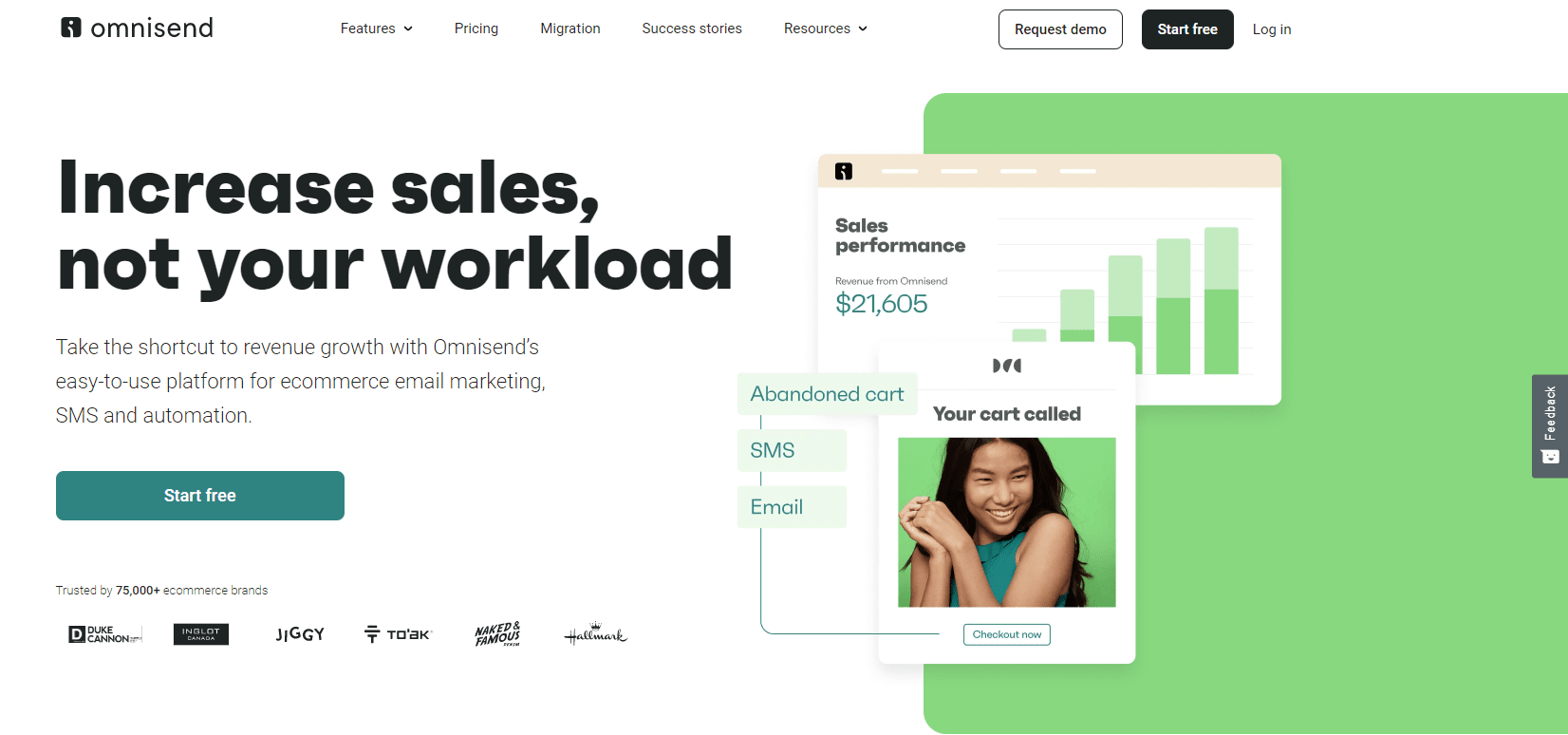
You have to link to an eCommerce platform to use a lot of their features, so it’s not as good for people who want to set up their own mailing lists or newsletters.
You could still use Omnisend for that, but you won’t be able to use many of its features.
What is Mailchimp?
Mailchimp started in the year 2001. It is a popular email marketing service with features like marketing CRM, tagging and segmentation, behavioral marketing, digital ads, postcard ads, and more.
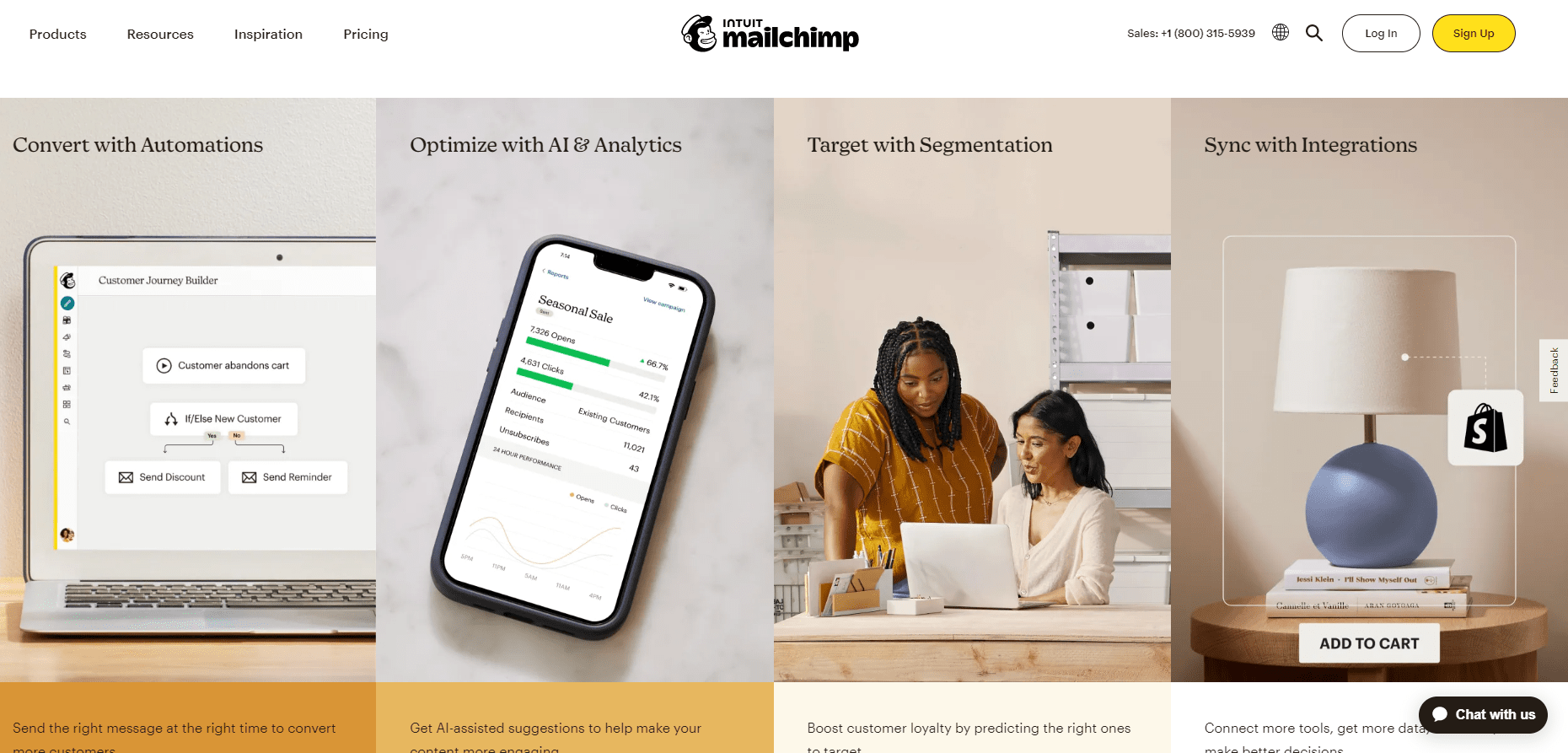
It’s for anyone, from small businesses to individuals, who wants to advertise their services to a large group of people.
Differences in Onboarding and Pricing
It’s easy to sign up for an account on Omnisend or MailChimp. Also, you can make an account on both platforms for free and use them with some limits as a free user.
Omnisend, for example, lets a free user send up to 2,000 emails per day and 15,000 emails per month.
This is a good choice for someone just starting out with email marketing, since free users of Omnisend can’t use any of the more advanced features, like SMS marketing.
On the other hand, a free MailChimp user can have a list of up to 2000 contacts. Now, let’s get into the specifics of how much these two platforms cost.
Omnisend Pricing
Omnisend has four different pricing tiers, and the price depends on how many contacts you have. Also, if you choose the annual plan, you can get a big discount on the price.
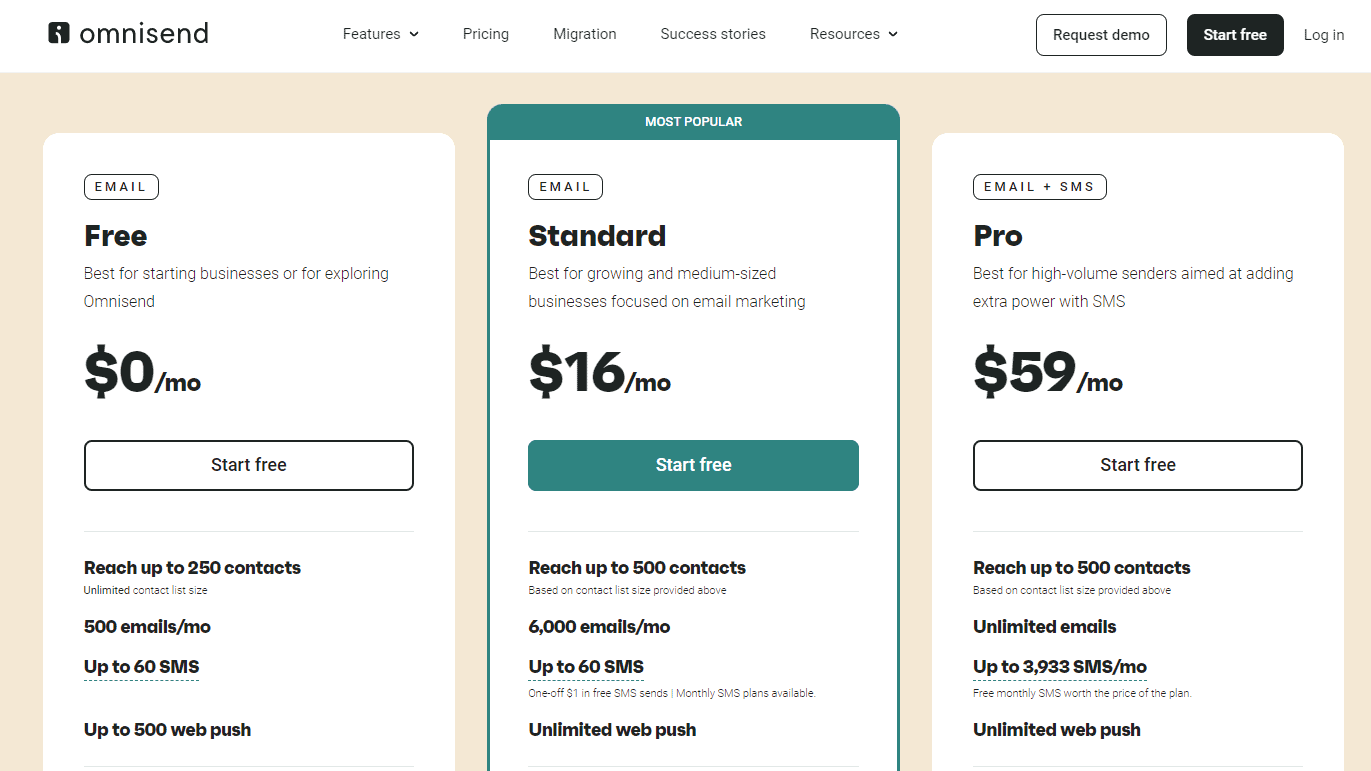
Free Tier
- Omnisend’s free base plan is the best way to try out the service.
- You can create, target, and send up to 15,000 personalized emails per month.
- Users’ newsletters will say that they were sent by Omisend.
- You can easily send out advertising emails.
- You can divide your contacts into up to 5 groups.
- You can have up to two signup forms going at once.
- You can make discount codes that work with your store that are made automatically.
- You can use some beautiful email templates that are already built in.
- Works with a number of third-party systems.
Standard Plan
- Omnisend’s Standard plan starts at $16 per month and can go up depending on how many contacts you have.
- You can create, target, and send personalized emails to (up to 12 times your list) emails per month.
- You can send SMS and MMS messages to your customers or contacts’ phones to get in touch with them.
- You can easily get tools for email and message automation, as well as tools for managing workflow.
- You can divide your contacts into up to 20 groups.
- You can have as many signup forms as you want at the same time.
- Integrates with a wider range of third-party systems than the free version.
Pro Plan
- Omnisend’s Pro plan starts at $99 per month and goes up depending on how many contacts you have.
- You can create, target, and send personalized emails to (up to 15 times your list) emails per month.
- You can send SMS and MMS messages to your customers or contacts’ phones to get in touch with them.
- You can easily get tools for email and message automation, as well as tools for managing workflow.
- You can divide your contacts into up to 50 groups.
- You can have as many signup forms as you want at the same time.
Enterprise Plan
- Omnisend’s Enterprise plan is a custom tier that is made to fit your needs.
- This is an Unlimited offer, which means that you can use all of Omnisend’s features as much as you want.
You should know that all paid versions of Omnisend let you try the system for free for 14 days. So, if you’re not sure, you can sign up for a free trial account and look around the platform to see if it meets your needs.
MailChimp Pricing
A perpetual free tier is also available as part of MailChimp’s pricing options.
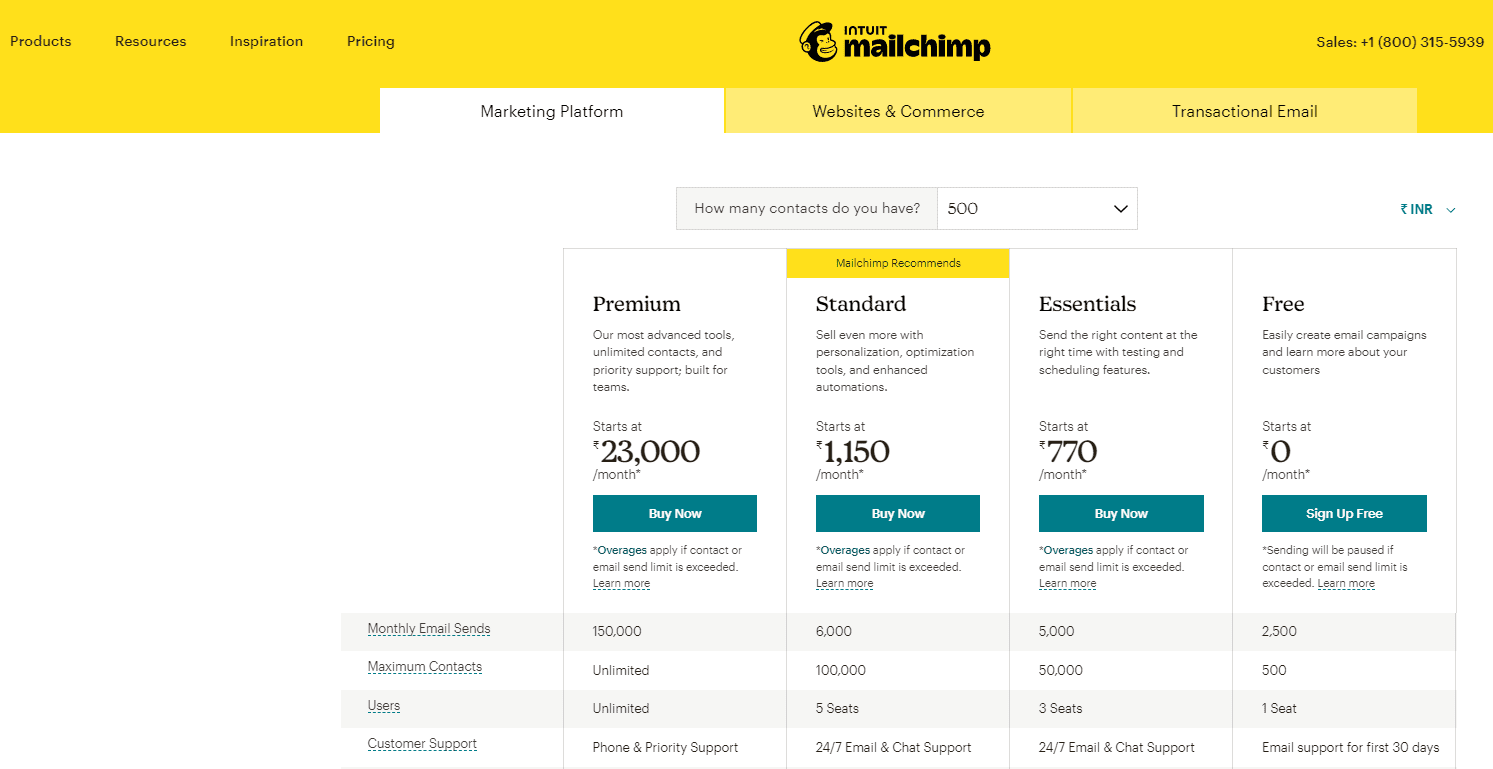
Free Tier
- You can use it for free and it has all the tools you need to get started.
- There is a limit of 2000 contacts per account.
- The Email Builder is available to you.
- Marketing CRM can be accessed here.
- Forms and landing pages can be created.
- MailChimp’s Creative Assistant is available to you.
- A Mailchimp domain and Website Builder are included.
Essential
- Business owners who want 24/7 support and more customization can take advantage of this offering.
- The monthly fee for 500 contacts starts at $10.25 and increases with the number of contacts you add.
- MailChimp offers email templates and A/B testing tools.
- Branding can be customized.
- 24/7 email and chat support are available to you.
- Everything in the Free tier is included as well.
Standard
- MailChimp’s Standard plan is perfect for companies looking for more automation and data-driven features.
- The monthly fee for 500 contacts starts at $15.31.
- Branching Points + Customer Journey Builder are included.
- Send Time Optimization can be used.
- Behavioral targeting can be used.
- Custom Templates are available.
- Your marketing materials should contain Dynamic Content.
- Everything in the Essential Plan is included as well.
Premium
- MailChimp’s Premium tier is designed for high-volume senders who want all marketing features and phone support.
- Pricing starts at $306.10 per month for 10,000 contacts.
- Standard offers everything you need.
- Utilize Advanced Segmentation.
- A multivariate test and a comparative report can be used.
- Priority Phone Support is available to you.
You may also like:
Omnisend vs Mailchimp – Differences in Creating Email Campaigns
With Omnisend, it’s easy to make newsletters that look great. Because it has a library of beautiful and professional email templates. You can easily change these templates to fit your brand.
You can save and use these changes again and again. If you have more than one store, you can even share the templates you’ve saved between the stores.
You can even make actionable emails for your eCommerce store that can help you make more sales.
The drag-and-drop Content Editor makes it easy to make campaigns with dynamic content blocks like Product Picker, Scratch Cards, Dynamic Discount Code, and Product Recommendations that are designed for eCommerce.
You can use a customer’s profile information, shopping history, and other filters to create audience segments that you can then target with your campaign or not.
You can improve your open rates by using the built-in Campaign Booster and A/B testing tool.
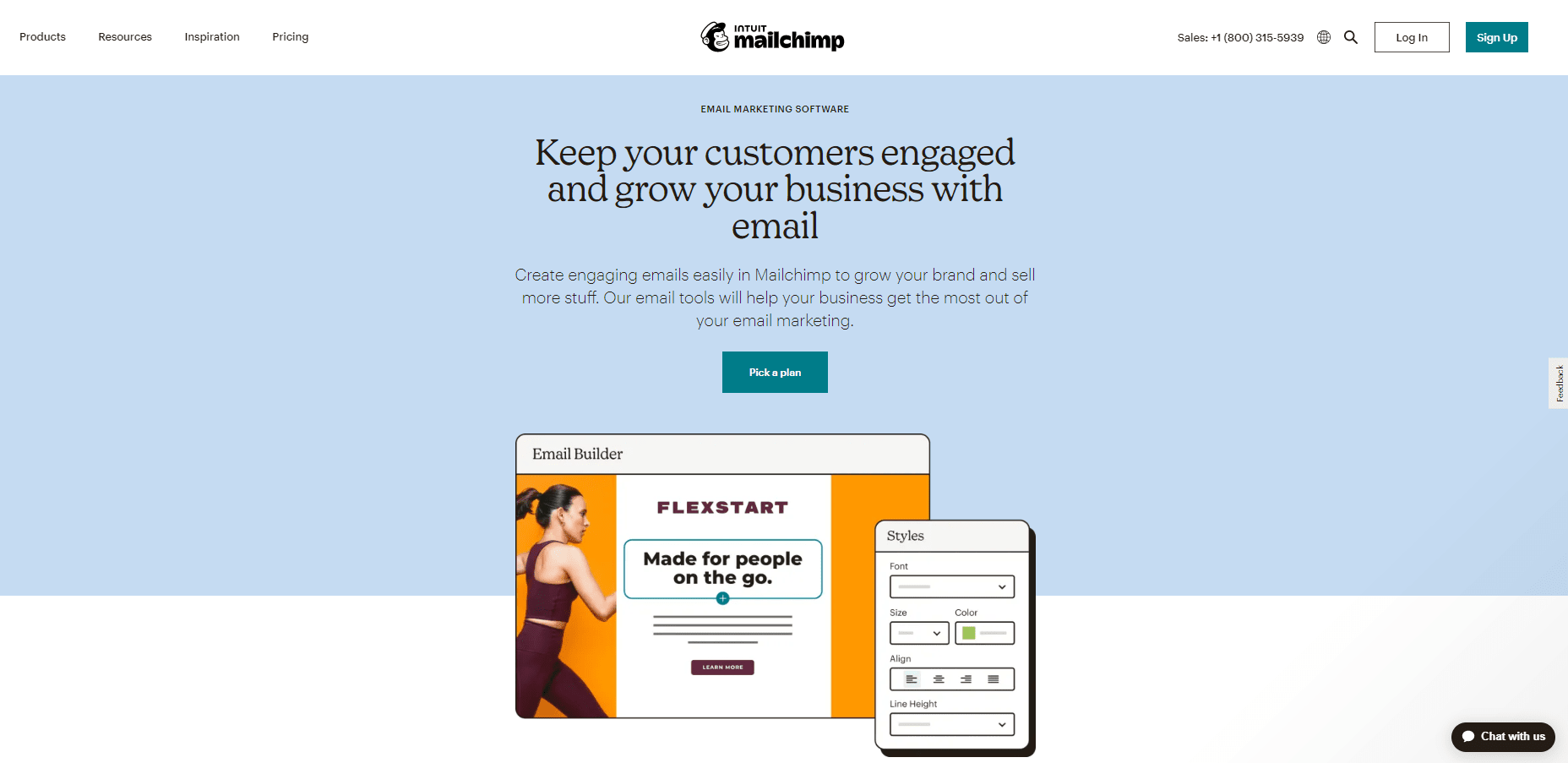
MailChimp also has a template library that you can use to make an email quickly that looks good. The drag-and-drop editor is easy to use and can help you make your emails look how you want them to.
Also, MailChimp’s content studio lets you store and organize all your images and files, so you can always find what you need for your campaigns.
MailChimp also lets you automate your marketing and keeps track of your campaigns with a real-time analytics system. You can also use API or SMTP to send transactional emails quickly and with your own name.
Use API or SMTP to send transactional emails like order confirmations quickly and with a personal touch.
Verdict – Even though both MailChimp and Omnisend have a template library and tools for making changes, I found that Omnisend’s features are better.
I will say that for simple users, this is a tie between the two platforms. But Omnisend can make your life easier if you want to use these email marketing tools for an eCommerce business.
Omnisend vs Mailchimp – Differences in Sending SMS/MMS
Omnisend is the only choice if your eCommerce business needs to send and receive SMS and MMS messages.
This is not possible with MailChimp. To send messages with Mailchimp, you must use a third-party system.
With Omnisend, on the other hand, you can use a single automated workflow to combine automated texts and emails and give your customers a consistent, personalized experience.
In other words, Omnisend lets you use SMS as a fully integrated channel that you can add to your automation or use for one-time campaigns.
Automated workflows with SMS are available for cart abandonment, birthdays, order confirmations, and shipping confirmations within the automation library. You only need a few clicks to turn these on.
Omnisend uses toll-free numbers that can handle a lot of calls. This means that there are no hidden costs for sending faster or more often. Omnisend also lets you send text-only messages to all country codes.
You can also get the phone numbers of your site’s visitors with TCPA-compliant SMS list-building tools like Popups, Landing Pages, Sign-up Boxes, and Wheel of Fortune.
Omnisend users on the Pro and Enterprise plans get credits added to their accounts every month. This means that users can save money on SMS costs while using omnichannel messaging to connect with customers in a way that gets better results.
Verdict: Omnisend is the clear winner when it comes to SMS marketing. It is a good choice among marketing automation tools because of its powerful marketing suite. Mailchimp doesn’t have this feature, which is a shame.
Omnisend vs Mailchimp – Differences in Sending Web Push Notifications
Use Web Push Notifications if you want to quickly retarget your customers with personalized push notifications that are built into your eCommerce marketing.
Like SMS marketing, Mailchimp doesn’t have this built into the system. But Omnisend makes it easy to add push notifications to workflows that are already automated.
You can combine push notifications with emails or use them as a backup for automated SMS to reach more people with the same message
Push Notifications can be used for:
- Push for Cart Abandonment
- Push for Transactional Messages
- Push for Browse Abandonment
- Push for Promotional events
Push notifications can certainly boost your eCommerce sales when used wisely.
Verdict: When it comes to Push Notifications, Mailchimp does not compete with Omnisend. Mailchimp lacks a robust Push Notification system, whereas Omnisend does. Omnisend is the clear winner in this case.
Omnisend vs Mailchimp – Differences in Creating Automated Workflows
Omnisend enables you to provide a consistent, personalized experience to your customers by reaching out to them via their preferred communication channels such as email, SMS, or Push alerts.
The ease with which Omnisend allows you to drag and drop these channels into a single workflow amazed me. To get started quickly, use the pre-built messages, subject lines, and workflow settings.
Inbuilt automation can be used for a variety of tasks, such as:
- Welcome eMails
- Product Abandonment
- Cart Abandonment
- Cross-selling
- Order Confirmation
- Shipping Confirmation
You may also add rule-based automated splits and A/B testing features.
The built-in reporting feature can assist you in determining what works best for your situation. You can also integrate third-party software to improve all of your automation needs.
In brief, Omnisend has highly advanced automation capabilities integrated directly into the system, thanks to a powerful Workflow Editor.
Marketing automation, on the other hand, is fairly limited in the case of Mailchimp. While it includes a few built-in capabilities, such as Cart Abandonments and Welcome Series, the functionality is limited.
You may also use Mailchimp to send transactional emails as well as triggered or scheduled emails.
Verdict – Omnisend’s automation is more comprehensive, advanced, and powerful. Despite the fact that Mailchimp provides a few basic features, Omnisend comes out on top in this comparison.
Omnisend vs Mailchimp – Differences in Setting Up Customer Segmentation
Omnisend was created with eCommerce enterprises in mind. It allows you to segment your audience based on various transactional events and buying behaviors.
Its clever client segmentation based on lifecycle aids in the retention of your most valuable customers. Omnisend assigns a lifecycle stage to each customer dynamically and displays this information in an easy-to-read lifecycle stage map.
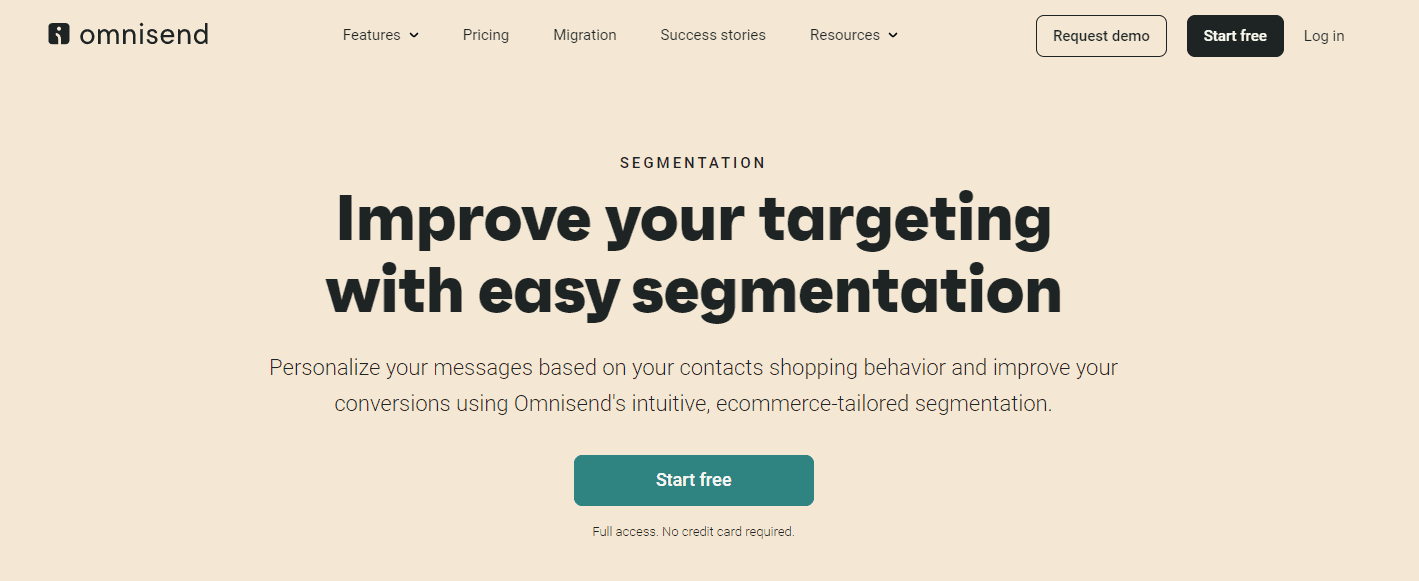
Mailchimp, on the other hand, has a simpler segmentation tool. It allows you to filter your contacts based on a common behavioral pattern as well as user attributes such as language, platforms, email clients, and so on.
Verdict –Mailchimp’s categorization tool is far from thorough if you run an eCommerce firm. It may be appropriate for small websites that require a restricted segmentation option. Omnisend is the way to go for segmentation on longer lists and functional eCommerce businesses.
Differences in Building Forms & Popups
Omnisend includes many built-in signup forms for collecting contacts and leads. Popups, Landing Pages, Wheel of Fortune, and Signup Boxes, for example, can be used to capture these leads.
Exit Popup can also be used to reduce bounce rates, reduce checkout abandonment, and increase signups. You may also specify the number of pages to browse before the popup appears, or limit it to specific pages of your store or website.
Popups can also be used to gather phone numbers and begin building your SMS list. You can develop forms that solely collect phone numbers or forms that collect both phone numbers and email addresses.
It’s worth noting that you can begin marketing operations with Omnisend even if you only have the phone number.
The permission information is collected using forms that are TCPA and GDPR-compliant. The forms are mobile-friendly. You may also build your contact list using any of the professional themes.
MailChimp also allows you to collect data using Sign Up forms. You can simply convert leads using the built-in signup and popup forms that are linked to your Marketing CRM.
You may even make powerful bespoke popups that appear when and where you want them to. You can also include a form that is editable on your website.
When you post a simple signup landing page across all of your channels to create leads, MailChimp allows you to share your form anywhere.
Verdict – MailChimp, and Omnisend both have enough capabilities to create a professional and successful signup form for your website. Both platforms allow you to start with any of their pre-built templates. There is no doubt that this is a tie.
Differences in Tracking Sales & Reporting
Omnisend, as a platform-oriented for online businesses of all sizes, includes robust eCommerce reporting and analytics solutions.
You can easily keep track of the sales that Omnisend is driving you with accurate revenue attribution and reporting using its reports. You may also track the sales generated by all campaigns.
With its extensive reporting features, you can identify which campaigns and workflows are contributing the most to your bottom line and which segments have the highest engagement.
You may also compare the performance of email, SMS, and other channels against a variety of crucial parameters.
Furthermore, Omnisend Benchmarks allows you to compare your brand’s performance to that of similar e-commerce sites in the industry.
Mailchimp also includes reporting capabilities in its system. You may get all of your marketing data from one location.
The growth, engagement, and revenue statistics can help you discover more about your audience’s activity. Mailchimp, like Omnisend, allows you to compare open, click, and unsubscribe rates to your industry peers.
However, when compared to Omnisend, the reporting in Mailchimp appears to be more rudimentary. In addition, unlike Omnisend, if you run a Shopify store, you will need third-party apps to use the full reporting feature.
Verdict: I’ll give Omnisend a tiny advantage here. Though both platforms have reporting elements built in, Omnisend appears to have more robust and advanced reporting and sales tracking functionality built right into the system.
Differences in Supported Integrations
Omnisend features pre-built connectors with nearly every software and web service you may require to run your online business.
These interfaces cover a wide range of topics, including Customer Support, Loyalty, Finance, Payments, eCommerce Platforms, and so on.
Furthermore, Omnisend categorizes its integrations into collections applicable to various eCommerce platforms such as Shopify, BigCommerce, Magento, and WooCommerce.
As your eCommerce business grows, you may require several third-party services. Omnisend is aware of it. The most recent list of Omnisend integrations may be found on the official website.
Mailchimp, on the other hand, includes built-in connectors with a few third-party applications. It should be noted that the Mailchimp catalog is not as diverse as Omnisend’s.
Mailchimp works well with systems such as Stripe, SimpleTexting, WordPress, ChargeBee, and others. Mailchimp interacts with 293 different platforms at the time of writing.
Verdict: Tie. Mailchimp and Omnisend both feature ready-made connectors with a variety of apps and services. While Omnisend specializes in services for internet businesses, Mailchimp has a more general portfolio.
I recommend that you go to the official websites and see if the service you’re looking for is on the list of integrations.
Quick Links:
Conclusion: Omnisend vs Mailchimp 2026
If you are looking for a platform that seems to be a Jack of all trades, you can try out MailChimp.
However, you must note that several other services often offer better features than MailChimp more economically.
Now, if you need a platform that does marketing automation in the best possible way, Omnisend is the way to go.
Overall, I found Omnisend as a more powerful tool to automate your marketing campaigns. It is particularly apparent if you are going to use the platform for your eCommerce business.
While MailChimp offers most of the basic email marketing tools, Omnisend has a more powerful suite of services under its umbrella.








